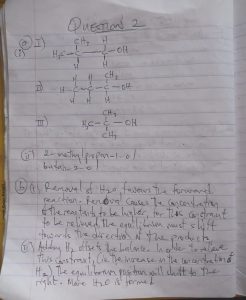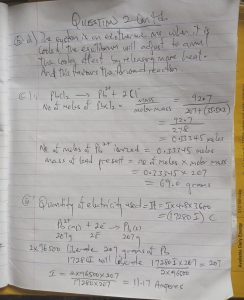
CHEMISTRY OBJ
01-10: ACBBBBACBA
11-20: ABBBADBBAB
21-30: CACBDCABCC
31-40: BDBDBBBADA
41-50: DAADBDBADD
COMPLETED
2023 WAEC GCE CHEMISTRY ESSAYS
(1ai)
(PICK TWO ONLY)
(i) Pressure
(ii) Volume
(1aii)
(i) Pressure – Pascal (Pa)
(ii) Volume – Cubic meter (m³)
(1b)
The formation of a sodium ion from a sodium atom is an example of oxidation because oxidation involves the loss of electrons or an increase in the oxidation state of an element. Sodium atom loses one electron to become a sodium ion, which has a +1 charge. As the atom loses an electron, it becomes less negatively charged, indicating oxidation.
(1c)
Chlorine (I) oxide has a low melting point due to weak intermolecular forces between its molecules. These weak forces, specifically van der Waals forces, are unable to hold the molecules together strongly, leading to a low energy requirement for breaking the intermolecular bonds and melting the substance.
(1d)
(i) Use purified copper (II) oxide and dilute trioxonitrate (V) acid to minimize impurities.
(ii) Perform the reaction in a controlled environment to prevent contamination from other substances.
(1ei)
Copper ions from the solution are reduced and deposited on the electrode as solid copper, while electrons are released from the electrode.
(1eii)
No visible changes would be observed since platinum does not react or dissolve in the electrolyte solution.
(1f)
Van der Waals forces between chlorine molecules are stronger than those between fluorine molecules because chlorine has larger and more polarizable electron clouds compared to fluorine. This results in stronger temporary dipoles and thus stronger Van der Waals forces.
(1g)
A reversible reaction is a chemical reaction that can proceed in both the forward and reverse directions. The products of the reaction can react with each other to form the original reactants.
(1h)
Postulate refers to a fundamental assumption or statement that is accepted without proof and forms the basis for further reasoning or development of a theory. It is a starting point or hypothesis that helps in the interpretation and understanding of chemical phenomena.
(1i)
Given:
Molar mass of sodium (Na) = 23g/mol
Avogadro’s number (Na) = 6.02×10²³mol-¹
Mass of an atom of sodium (m) = (Molar mass of sodium)/(Avogadro’s number)
m = 23/(6.02×10²³mol-¹)
m = 3.82×10-²³g
(1ji)
Graham’s law states that the rate of diffusion of a gas is inversely proportional to the square root of its molar mass.
(1jii)
The melting point of a sample of a compound is related to its purity in the sense that a pure compound will have a specific and well-defined melting point. Impurities in the sample can cause the melting point to decrease or become broader, thus indicating a lower purity.
NUMBER 2


(4ai)
Air is a mixture of gases, primarily composed of nitrogen, oxygen, carbon dioxide, and trace amounts of other gases.
(4aii)
Nitrogen
(4aiii)
A noble gas is an element from Group 18 of the periodic table, characterized by its stable and inert nature.
(4aiv)
(i) They are chemically inert
(ii) They have a full outer electron shell
(iii ) They exist as colorless, odorless gases at room temperature.
(4bi)
(PICK ANY TWO)
(i) Calcium chloride
(ii) Sodium sulfate
(iii) Potassium hydroxide
(iv) Anhydrous calcium sulfate
(4bii)
N2 + 3H2 —-> 2NH3
(4biii)
It is often done through upward displacement of air or downward delivery into a container.
(4biv)
Differences in the method of collection of gases depend on factors such as the gas’s density, solubility, and reactivity with atmospheric components.
(4ei)
-Haematite undergoes reduction
-Coke acts as a reducing agent and provides heat.
-Limestone undergoes decomposition to form calcium oxide.
(4eii)
Cast iron is brittle and contains a higher percentage of carbon compared to wrought iron, which is malleable and has a lower carbon content.
(4eiii)
Conditions favoring the conversion of sulfur (IV) oxide to sulfur (VI) oxide include low temperature, high pressure, and the presence of a catalyst.
(4di)
Both diamond and graphite have high melting points due to the strong covalent bonds between carbon atoms in their structures. In diamond, each carbon atom forms four strong covalent bonds in a tetrahedral structure, while in graphite, carbon atoms are arranged in layers held together by weak van der Waals forces.
(5a)
Soap is manufactured through a process called saponification. In this process, pellets of sodium hydroxide (NaOH) and vegetable oil are used as the main ingredients. First, the vegetable oil is heated, and then the heated vegetable oil is mixed with sodium hydroxide pellets. This mixture is stirred continuously until a thick, creamy consistency is achieved. This mixture is then left to cool and solidify into soap bars. The sodium hydroxide reacts with the fatty acids present in the vegetable oil, resulting in the formation of soap molecules.
(5bi)
The industrial preparation of oxygen from air involves a process called fractional distillation. Air is first compressed and cooled, causing it to liquefy. This liquefied air is then subjected to fractional distillation, a process that separates the different components of air based on their boiling points. Oxygen, which has a lower boiling point than nitrogen, is separated and collected as a pure gas.
(5bii)
(i) oxygen: Oxygen supports combustion and is necessary for a flame to burn.
(ii) Hydrogen: hydrogen is highly flammable and can readily ignite.
(5ci)
(i) Calcium hydroxide: It helps to neutralize any acidic components and improve the overall quality of the water.
(ii) Calcium: is an essential nutrient for human health and is important for the development and maintenance of strong bones and teeth.
(5cii)
(i) Natural sources
(ii) Fossil fuel extraction and combustion
(5ciii)
When sulfur reacts with iron, iron sulfide (FeS) is formed. This reaction can be represented by the equation:
Fe + S -> FeS
(5di) The term hardness of water refers to the concentrationof dissolved minerals, particularly calcium and magnesium ions. Hard water can cause build-up and scaling in pipes and appliances, reduce the effectiveness of soaps and detergents, and can also affect the taste and odor of water.
(5dii)
2H2SO4 + 2NaCl → 2HCl + Na2SO4
(5diii)
Fe2O3 + 3CO → 2Fe + 3CO2

Leave a Reply